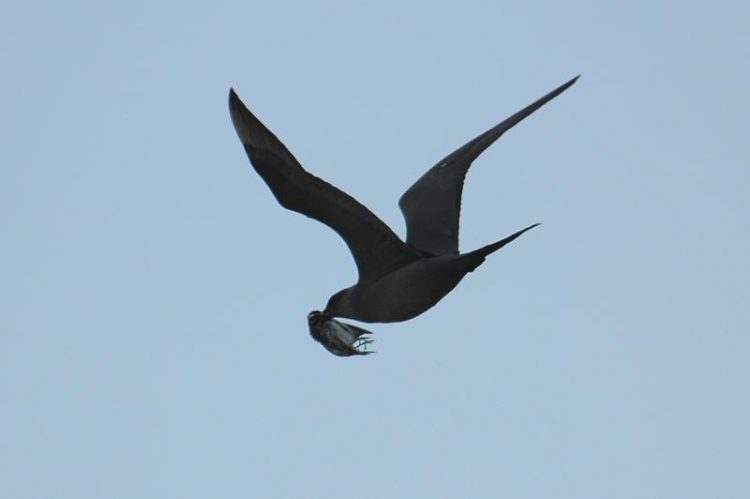Predators predict longevity of birds

A pomarine skua (Stercorarius pomarinus) with a male Lapland longspur (Calcarius lapponicus) in its beak (taken at Barrow, Alaska). © MPIO Seewiesen/ W. Forstmeier
Researchers of the Max Planck Institute for Ornithology in Seewiesen have now found a possible general mechanism explaining differences in longevity. They investigated life history data of nearly 1400 bird species and found that avian life span varies considerably across the globe, and that much of this variation can be explained by the species’ body mass and clutch size and by the local diversity of predator species. With their data the researchers were able to confirm a key prediction of the classical evolutionary theory of ageing that had been proposed more than 50 years ago.
It is well-known that organisms vary widely in life-span. Whereas some fish, turtles or even invertebrates can become hundreds of years old, the neon pygmy goby – a small fish – reaches ripe old age at only 60 days. In birds, variation in life-span extends from parrots such as the Sulphur-crested cockatoo that can become more than 100 years old, to the small Allen’s hummingbird with a maximum life-span of only 4 years, a 25 fold difference. How can this variation be explained?
The classical evolutionary theory of ageing, first proposed by the famous evolutionary biologist George C. Williams over 50 years ago, gives an answer. The theory predicts that high mortality rates in adult animals due to predation, exposure to parasites and other randomly occurring events will be associated with shorter maximum life-spans. This is because under high external mortality most individuals will already be dead (eaten or succumbed to disease) before natural selection can act on rare mutations that cause healthier ageing. The theory has since been further developed and tested in a number of experimental and comparative studies. Yet contradictory results have caused scientists to cast doubt on its validity.
Mihai Valcu and Bart Kempenaers from the Max Planck Institute for Ornithology in Seewiesen together with colleagues from New Zealand and Switzerland have now tested this theory using a comprehensive database on estimates of maximum life-span of 1396 bird species, 1128 from free-living species and 268 from birds kept in captivity. The researchers used a global distribution map of these species, included data on their morphology and reproductive rate, and estimated predation rate.
By means of complex statistical analysis methods they found that in the investigated bird species maximum longevity is negatively related to the number of predator species occurring within the same geographical area. This means that the more predator species are present in the same habitat and the more evenly they are distributed, the lower is the life span of the respective species. This relationship supports the classical theory of ageing, and remains valid when other life history traits known to influence longevity such as body mass and clutch size are included into the statistical model. Indeed, larger species live longer, and those that reproduce fast (lay more eggs) live shorter lives.
Remarkably, the observed pattern showing longer life-spans when fewer predators are present emerges no matter how the analysis was done: at the species level, at a finer regional scale (groups of species within a certain area) or even when comparing entire bioregions. “With our results of a negative relationship between predation pressure and longevity that is largely independent of other key life history traits we were able to confirm the universality of the 50 year old evolutionary theory of ageing on a broad geographical scale” concludes Mihai Valcu, first author of the study. At least in birds, where the necessary data are available for many species, the theory seems to hold.
Weitere Informationen:
http://orn.iwww.mpg.de/3126188/news_publication_8167842?c=2168
Media Contact
All latest news from the category: Life Sciences and Chemistry
Articles and reports from the Life Sciences and chemistry area deal with applied and basic research into modern biology, chemistry and human medicine.
Valuable information can be found on a range of life sciences fields including bacteriology, biochemistry, bionics, bioinformatics, biophysics, biotechnology, genetics, geobotany, human biology, marine biology, microbiology, molecular biology, cellular biology, zoology, bioinorganic chemistry, microchemistry and environmental chemistry.
Newest articles

Innovative 3D printed scaffolds offer new hope for bone healing
Researchers at the Institute for Bioengineering of Catalonia have developed novel 3D printed PLA-CaP scaffolds that promote blood vessel formation, ensuring better healing and regeneration of bone tissue. Bone is…

The surprising role of gut infection in Alzheimer’s disease
ASU- and Banner Alzheimer’s Institute-led study implicates link between a common virus and the disease, which travels from the gut to the brain and may be a target for antiviral…

Molecular gardening: New enzymes discovered for protein modification pruning
How deubiquitinases USP53 and USP54 cleave long polyubiquitin chains and how the former is linked to liver disease in children. Deubiquitinases (DUBs) are enzymes used by cells to trim protein…



